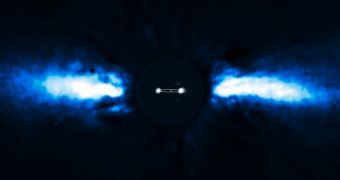A team of astronomers recently used the Magellan Telescopes to detect a new extrasolar planet with a mass 11 times that of Jupiter. This super gas giant orbits its parent star at 650 times the average distance between the Earth and the Sun, something that was previously thought impossible.
There is no equivalent in our solar system for this world. Neptune is the farthest planet from the Sun, and it tends to orbit the star at a mean distance of 30.1 Earth-Sun distances, or astronomical units. That is the equivalent of 4.5 billion kilometers, or 2.8 billion miles.
But the newly-found world, dubbed HD 106906b, orbits its parent star at a distance of about 650 astronomical units, which is the equivalent of 97 billion kilometers, or 60 billion miles. No existing model on planet formation or evolution can explain this monumental distance, Daily Galaxy reports.
The exoplanet was discovered using the Adaptive Optics (MagAO) system on the Magellan Telescopes, which is capable of correcting the atmospheric distortions that affect incoming light. The twin Telescopes are based at the Las Campanas Observatory, in Chile.
The pair of 6.5-meter (21.3-foot) telescopes was developed and operated by a consortium including the Massachusetts Institute of Technology, the University of Arizona, Harvard University, the University of Michigan, and the Carnegie Institution for Science.
Standard planetary formation models suggest that worlds appear through the accumulation of dust particles within the debris disks surrounding newly formed stars. The key element here is that these disks are usually in relatively close proximity to the stars.
The farther away we go from a parent star, the least likely it becomes for large worlds to develop. This is why a world 11 times the mass of Jupiter occupying such an extreme orbit is an impossibility. One potential explanation is that the star and its planet represent a failed binary system.
“A binary star system can be formed when two adjacent clumps of gas collapse more or less independently to form stars, and these stars are close enough to each other to exert a mutual gravitation attraction and bind them together in an orbit,” research leader Vanessa Bailey says.
“It is possible that in the case of the HD 106906 system the star and planet collapsed independently from clumps of gas, but for some reason the planet's progenitor clump was starved for material and never grew large enough to ignite and become a star,” adds the expert, who is based at the University of Arizona's Department of Astronomy.
Studies of the massive exoplanet, conducted using the European Southern Observatory's (ESO) Very Large Telescope at La Silla Observatory, in Chile, revealed that the distant world still glows with residual heat from its formation.
Astronomers estimate that HD 106906b is roughly 350 times younger than Earth, at just 13 million years. Its surface is heated to around 1,500 degrees Celsius, or 2,700 degrees Fahrenheit, which is why it releases most of its energy as infrared light.

 14 DAY TRIAL //
14 DAY TRIAL //